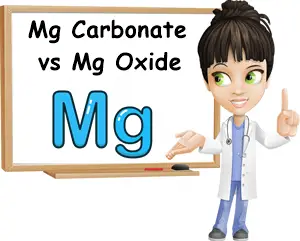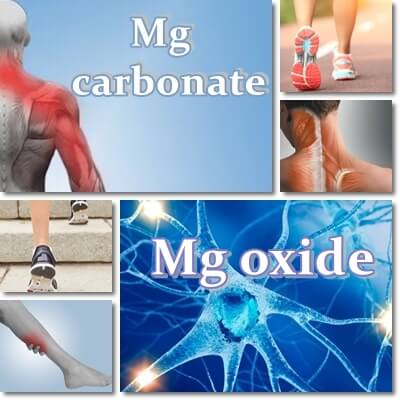Magnesium carbonate and oxide are two of the most common forms of the mineral and the most widely used in dietary supplements. Both are inorganic forms of the mineral which means they have a lower bioavailability compared to the organic forms and, consequently, also lower absorption rates. Actually, both forms have some of the lowest absorption rates of all formulations: magnesium carbonate absorption rate is estimated to not exceed 20% in the best of cases, while magnesium oxide absorption rate is estimated to not exceed 10% in the best of cases.
Even so, there are benefits to supplementing with both magnesium carbonate and oxide. Despite having poor bioavailability and lower uptakes than most other forms, they do help correct a deficiency of the mineral and associated symptoms and side effects. Supplementing with either one of the two forms holds benefits for the digestive, cardiovascular and nervous systems, muscles, bones, mental health and even blood sugar control in diabetes.

What is magnesium carbonate? Magnesium carbonate is an inorganic magnesium salt in which the mineral magnesium is bound to carbonate, the salt of carbonic acid. It occurs in nature in the form of magnesite. Interestingly, magnesite also serves as raw material for the production of magnesium oxide. Heating magnesite at high temperatures causes it to separate into carbon dioxide and magnesium oxide, another popular form of the mineral widely used in dietary supplements. Magnesite, the naturally occurring form of magnesium carbonate, is a white solid and may contain very small amounts of other minerals as well, including but not limited to iron and manganese.
What is magnesium oxide? Magnesium oxide (alternative names: magnesia, magnesia alba) is an inorganic form of magnesium and possibly the most common form used in dietary supplements. It is obtained from the naturally-occurring form of magnesium carbonate, known as magnesite, by heating the latter at high temperatures. Despite having the lowest absorption rate of all forms, as a dietary supplement, it has the highest amount of elemental magnesium of all forms (meaning it contains the most actual magnesium).
Magnesium oxide vs magnesium hydroxide. Magnesium oxide is obtained from the naturally-occurring form of magnesium carbonate known as magnesite. It can also be obtained from the naturally-occurring form of magnesium hydroxide known as brucite. The process is the same: exposing the mineral forms to high temperatures causes decomposition of constituent elements, resulting in the production of magnesium oxide. Magnesium hydroxide is commonly used in antacids and laxatives (milk of magnesia, Maalox) and has one of the poorest bioavailability and absorption rates.

Mg carbonate and oxide absorption
Studies show magnesium carbonate absorption rate averages at 10%. In the best of cases, absorption can go as high as 20%. This is because Mg carbonate is an inorganic form of the mineral and, like all inorganic forms, has a modest bioavailability. What this means is that very little of it is actually taken up by the body. However, magnesium oxide absorption rate is even lower, averaging only 4% or up to 10% in the best of cases. Mg oxide is also an inorganic form of the mineral and, as a result, has poor bioavailability. In other words, this particular formula is poorly absorbed at the intestinal level. But because it has the highest amount of elemental magnesium out of all forms of the mineral (meaning more actual magnesium in the supplement doses), you do get to absorb something despite absorption rates as low as 4%.
Benefits and uses
Magnesium carbonate and oxide hold similar benefits. They are used primarily for correcting a deficiency of the mineral and associated side effects. Uses include: constipation, indigestion, heartburn, stomach acidity, muscle spasms and painful cramps (restless leg syndrome, eyelid twitching, needles and pins sensation, calf or foot cramps, leg cramps at night or after exercise), poor bone density, mood disorders, arrhythmia and even hypertension.
But given that both forms have overall poor absorption rates, benefits resulting from supplementation may vary greatly. Generally, people tend to respond better to magnesium carbonate than to oxide. Most likely benefits include: constipation relief, indigestion and heartburn relief, reduced stomach acidity and potentially less severe or less frequent muscle spasms or cramps and cardiac manifestations (extrasystoles, palpitations and other forms of irregular heartbeat or arrhythmia).
Higher doses of either magnesium oxide or carbonate can potentially produce more significant benefits. For example: less intense and less frequent foot, calf or leg cramps at night or after exercising, less intense and less severe migraines, lower blood pressure, better mood and potential benefits for anxiety, depression, improved bone density.
Forms and dosage
Magnesium oxide doses are typically in the range of 250, 400 or 500 mg per tablet/capsule/soft gel capsule. Magnesium hydroxide is commonly available in liquid form in bottles of 8 and 16 fluid ounces (236.6/240 ml, 472/473 ml) with recommended doses of 5 or 10 ml a day, depending on use (typically for indigestion and constipation relief). Magnesium carbonate is available in tablet, capsule or powder form as well as liquid form in doses of 125, 135, 150, 300, 400, 450 or 500 mg per tablet/capsule/soft gel capsule, 150 mg, 300, 400 or 450 mg per sachet or bag (to be dissolved in water) or in bottles of 8 and 16 fluid ounces with recommended doses 5 or 10 ml, depending on use (typically for indigestion or constipation relief). Vitamin D, vitamins B1, B6, B9, B12, vitamin C, calcium, potassium, zinc or co-enzyme Q10 may be added too to optimize absorption or increase benefits for certain conditions.
Side effects and contraindications
Common: Side effects as a result of supplementation with magnesium oxide or carbonate are mainly associated with excessive intakes and may include digestive upset, loose stools and diarrhea, nausea, vomiting, abdominal cramps.
Rare: Allergic reactions are an extremely rare side effect – if you experience skin redness, itching, peeling or blisters, swelling of the face, throat or tongue, difficulty breathing, wheezing, hoarseness, dizziness and low blood pressure, chest tightness, fainting sensation, seek medical help immediately. Low blood pressure, lethargy and muscle weakness are rare side effects associated with excessive intake of the mineral.
Contraindications: kidney disease. Kidney disease could prevent normal elimination of the mineral through urine and predispose to high blood magnesium levels and associated side effects. Talk to your doctor more about the right dosage of the mineral for you if you have kidney problems.
Conclusion
Is magnesium carbonate or oxide good for correcting a deficiency? Neither form is the absolute best form of the mineral, not even close to the best ones. But both can be used for correcting a deficiency, with varying results. The more magnesium-deficient a person is, the more of the mineral they are likely to absorb, even from forms with otherwise poor absorption rates such as the oxide and even the carbonate. But overall, of the two, the carbonate form is better than the oxide and likely to be more effective as well as generate better results.
